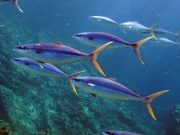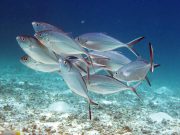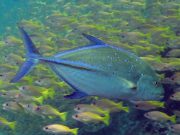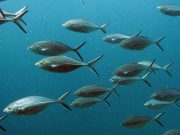Dykning med Jacks, löpare och trevallies
Lanta Marina Liv | Carangidae
Familjen Carangidae omfattar cirka 200 arter av medelstora till stora fiskar, inklusive trevallies, runners, jacks, pompanos, makrillar och scads.
Kroppsformerna varierar kraftigt, från långsträckta och strömlinjeformade till mycket djupa och smala, och många arter är lätta att upptäcka under dykturer på Koh Lanta.
Jacks, runners och trevallies har två ryggfenor, en mycket smal stjärtbas och en stark stjärt, antingen kluven eller halvmåneformad. De har små fjäll som ibland är svåra att se. De flesta arter är snabbsimmande rovfiskar som jagar i vattnen ovanför rev och på öppet hav.
Vissa arter är nästan helt silverfärgade, medan andra är mörka eller har färgade ränder eller streck på huvudet, kroppen eller fenorna. Vissa arter kan ändra mönster och ungarna hos många arter har ränder eller fläckar som bleknar eller försvinner med åldern.
5 arter finns på denna sida:
Rainbow Runner
(Elagatis bipinnulata)

Elagatis bipinnulata @ Koh Haa
The Rainbow Runner is a large fish, with a long, slender, silvery, darkish-blue body. The body has two lighter blue stripes, sometimes with yellowish stripe between them, and a large, forked tail. The fins are usually dark, with an olive or yellow tint.
The Rainbow Runner may grow to 120 cm, but usually observed in the 50 cm - 70 cm range. This is a fast-swimming pelagic species, usually seen in small schools on the outer reef edge. The diet includes small fish, squid, and a wide variety of planktonic crustaceans.
Barcheek Trevally
(Carangoides plagiotaenia)

Carangoides plagiotaenia @ Koh Haa
The Barcheek Trevally has a silvery body and is distinguished by a narrow dark bar on the gill cover, slightly protruding lower jaw and 'barred cheek' colouration.
This species grows to 42 cm and forms small groups in shallow water along the edges of steep outer reef and lagoon slopes.
The Barcheek Trevally's diet includes small fish and bottom-dwelling crustaceans.
Gold-Spotted Trevally
(Carangoides fulvoguttatus)

Carangoides fulvoguttatus @ Koh Bida
The Gold Spotted Trevally is often seen patrolling the reefs in small groups in search of food. The body is silvery with 5 faint dark vertical bars along the side and many small yellow or golden spots. In larger adults, there are 3 or 4 dark blotches along the middle of the side.
The Gold-Spotted Trevally grows to 130 cm, but more often observed in the 50 cm - 80 cm range. The diet includes shrimp, cephalopods and fishes. Small groups of 5 - 10 individuals are often seen hunting smaller species such as snapper and fusiliers along the reef edge, darting frantically in and out of fish schools to catch their prey. Occasionally groups of Gold-Spotted Trevally are seen forcing schools of fusiliers in deeper water to create 'bait balls' for protection.
Bluefin Trevally
(Caranx melampygus)

Caranx melampygus @ Koh Bida
The Bluefin Trevally has a tapered snout and a silvery bluish body with numerous blue and black spots on the upper half of the body and electric blue fins, except the pectoral fins, which are yellow.
The Bluefin Trevally is often seen in small groups hunting aggressively along the reef, attacking schools of smaller fish such as snappers and fusiliers. This species grows to 100 cm but more often observed 40 cm - 60 cm. The diet is mainly fish, but also includes cephalopods such as squid, and crustaceans.
Herring Scad
(Alepes vari)

Alepes vari @ Koh Haa
The herring scad has a greyish-blue to bluish-green upper body, fading to a silvery lower body. This species has two dorsal fins, the first of which is rather short. The tail fin can have a yellowish tinge to it, and males have darker fin tips than females, especially the tail fin lobes.
The numerous small scales give the body an appearance of vertical stripes or ridges.
The herring scad is the largest member of the scad genus Alepes, maximum length 56 cm, but more commonly observed around 30 cm.
Dense schools of herring scad can form close to the reef, swimming near the surface, high above the substrate (bottom). This species feeds mainly on small fish and crustaceans.
Dykning med Jacks, löpare och trevallies runt Koh Lanta
Dykning och Snorkelutflykter
Om du vill ha en chans att se Jacks, löpare och trevallies på en av våra dagliga högsäsongs dykresor från Koh Lanta, skicka oss ett e-postmeddelande till info@diveandrelax.com.
Följ med på våra dykresor med speedboat under högsäsong till några av Thailands bästa dykplatser och njut av små grupper, korta restider och fokus på personlig service, säkerhet och nöje.
Är du ännu inte certifierad dykare? Lär dig att dyka på Koh Lanta med den 3-dagars SSI Open Water Diver-kursen.
Boka online och spara 10 % på dykresor och dykkurser på Koh Lanta.
Ta Reda på Mer
Guider för Marina Djur och Växter i Indo-Stilla Havet
- Allen, G., Steene, R., Humann, P., DeLoach, N. (2003) Reef Fish Identification, Tropical Pacific. Jacksonville, FL., USA: New World Publications, Inc., ISBN 1-878348-36-1.
- Humann, P., DeLoach, N., (2010) Reef Creature Identification, Tropical Pacific. Jacksonville, FL., USA: New World Publications Inc., ISBN 978-1-878348-44-9
- Debelius, H. (2013) Indian Ocean Reef Guide. Frankfurt, Germany: IKAN - Unterwasserarchiv, ISBN 978-3-939767-52-7.
- Debelius, H. (2004) Nudibranchs and Sea Snails, Indo-Pacific Field Guide. Frankfurt, Germany: IKAN - Unterwasserarchiv, ISBN 3-925919-51-1
- Erhardt, H., Knop, D. (2015) Corals Indo-Pacific Field Guide. Frankfurt, Germany: IKAN - Unterwasserarchiv, ISBN 3-925919-69-4.
- Veron J.E.N., Stafford-Smith M.G., Turak E. and DeVantier L.M. (2016). Corals of the World
